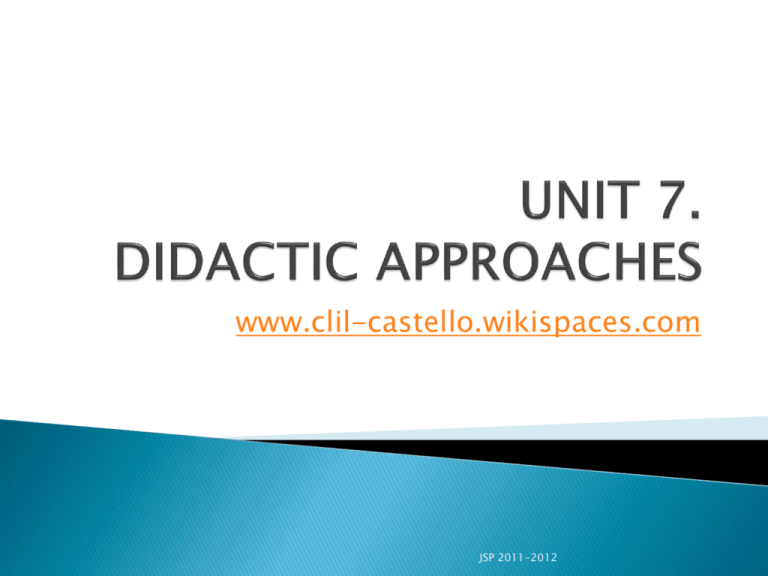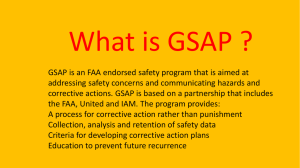unit 7. didactic approaches - clil-castello
advertisement

www.clil-castello.wikispaces.com JSP 2011-2012 To show different aspects taking part in the didactic approaches to language teaching. To know the European Council approach towards language teaching and learning and the repercussion in the didactic approach. To become aware of the different competences taking part in the communicative competence. To reflect about our own didactic approach. JSP 2011-2012 Initial questionnaire: discussion. (15 min.) Teacher’s speech on the topic (30 min.) Task 1: Questionnaire for group work (30 min.) Task 2: Questionnaire for group work (40 min.) Task 3: Writing a composition at home. JSP 2011-2012 Which methodological and organizational measures should be taken in a school to put into practice a multilingual programme? One of the main objectives of linguistic learning is that it should be useful for communication. What do you think of this statement? Do you think it has always been so? “What we know of a language is directly related to the context where we have learnt it”. Do you agree with this statement? If not, according to you, what consequences will it have in the teaching of languages? JSP 2011-2012 What does the statement “Language has to be the instrument and the object of learning” mean? Do you agree with the following statement: “Good levels of language cannot be achieved with hours of language and the textbook”? If the statement is true, how can it be achieved? What does the curriculum say about this? JSP 2011-2012 AN ACTION-ORIENTED APPROACH We learn by doing. Any act of language learning or teaching is concerned with the following dimensions: Individual’s general competences Communicative language competence Language activities Domains Strategies, Tasks and Texts Language processes Contexts JSP 2011-2012 COMPETENCE: knowledge, skills and characteristics that allow a person to perform actions. ◦ KNOWLEDGE: Empirical knowledge and Academic knowledge ◦ SKILLS AND KNOW-HOW: ability to carry out procedures ◦ EXISTENTIAL COMPETENCE: individual characteristics, personality traits and attitudes. ◦ ABILITY TO LEARN: a mixture of the previous items. JSP 2011-2012 RECEPTIVE ACTIVITIES: ◦ Listening ◦ Reading PRODUCTIVE ACTIVITIES: ◦ Speaking ◦ Writing INTERACTIVE ACTIVITIES: ◦ Conversation ◦ Mediation JSP 2011-2012 Strategy: organised, purposeful and regulated line of action to carry out a task. Task: purposeful action to achieve a given result. Text: any sequence of discourse related to a specific domain. The action-oriented approach is centred on the relations between: ◦ The use of strategies linked to one’s competences ◦ The perception of the situation or context (domain) ◦ The task or tasks to be accomplished The relationship between strategies, tasks and text depends on the nature of the task. JSP 2011-2012 Broad sectors of social life in which social agents operate. Public domain: ordinary social interaction Personal domain: family relations and individual social practices. Educational domain: learning context. Occupational domain: activities and relations in the exercise of a job. JSP 2011-2012 Acquisition or learning? How do learners learn? ◦ Sufficient meaningful input exposure = acquisition. ◦ Sufficient meaningful input exposure + active participation in communicative interaction = acquisition. ◦ Studying language rules and vocabulary = comprehesion and use (conscious learning) Learners do not necessarily learn what teachers teach. Conscious learning + sufficient practice JSP 2011-2012 Linguistic competence Sociolinguistic competence Pragmatic competence JSP 2011-2012 An uneven and changing competence. Allows language switching. Not the simple addition of monolingual competences. Promotes the development of linguistic and communicative awareness and metacognitive strategies. Speeds up subsequent learning. JSP 2011-2012 DIRECT EXPOSURE TO AUTHENTIC L2 DIRECT EXPOSURE TO SELECTED L2 DIRECT PARTICIPATION IN COMMUNICATIVE INTERACTION IN L2 DIRECT PARTICIPATION IN SELECTED TASKS IN L2 AUTODIDACTICALLY GRAMMAR-FOCUS LEARNING OF L2 USING L1 AS THE LANGUAGE OF INSTRUCTION GRAMMAR-FOCUS LEARNING OF L2 USING L2 AS THE LANGUAGE OF INSTRUCTION OTHERS. JSP 2011-2012 1.- Do you think any of this approaches is more relevant than the rest to teach a language? 2.- It is the same in L1, L2 or L3? 3.- Which approaches do you normally follow in your everyday lessons? 4.- Dou you use them because of the level of the students, because of the aims of the curriculum, because of the type of textbooks? JSP 2011-2012 1. 2. 3. 4. 5. 6. 7. 8. 3 Groups of six persons 1 secretary per group 15 minutes discussion 2 persons of each group go to another group 10 minutes discussion 2 persons of each group go to another group 10 minutes discussion Big group discussion JSP 2011-2012 GROUP 1: METHODOLOGY 1.-The role of teachers, learners and media. 2.-Textual considerations 3.- Written considerations 4.- Tasks, activities and texts. 5.- Communicative strategies. 6.- General competences. JSP 2011-2012 GROUP 2: LINGUISTIC COMPETENCES 7.- Vocabulary and lexical selection. 8.- Grammatical competence. 9.- Formal exercises. 10.- Pronunciation. 11.- Orthography. JSP 2011-2012 GROUP 3: OTHER CONSIDERATIONS 12.- The learner’s sociolinguistic competence. 13.- The learner’s pragmatic competence. 14.- Errors and mistakes. BIG GROUP CONCLUSIONS: secretaries JSP 2011-2012 Writing: a) Do you think that working on the curricular basic skills means a significant change in our nowadays job? b) From your viewpoint, which are the main challenges our educational system has for the 21st century? What do you think our pupils will need to become good citizens, competent, …? JSP 2011-2012 THANK YOU www.clil-castello.wikispaces.com JSP 2011-2012



